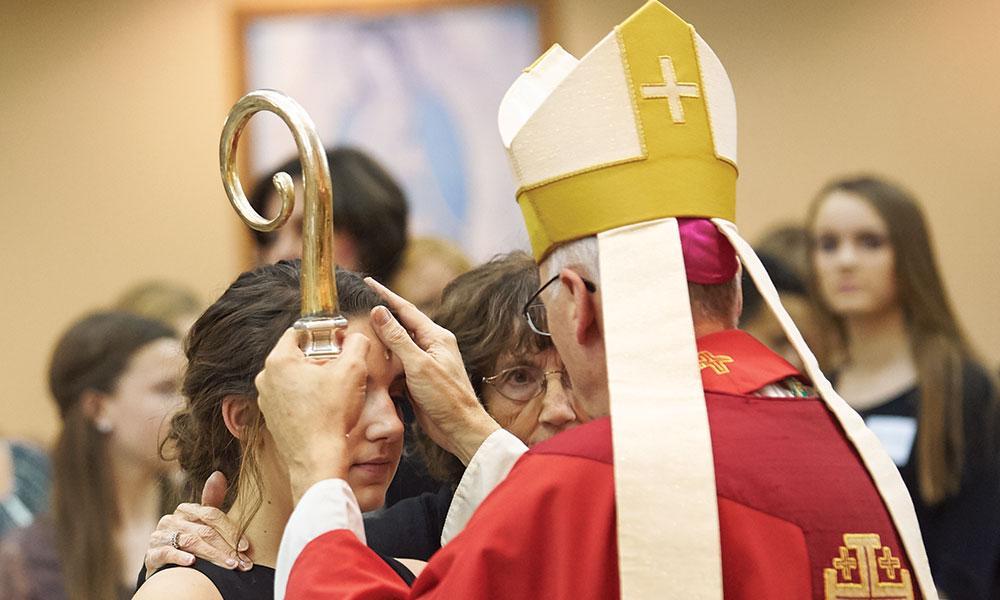
Encountering Jesus in Confirmation
In the sacrament of baptism, a catechumen (a person of at least seven years of age who is asking for baptism) or a godparent (a person who actually speaks for an infant or small child asking for baptism) is asked during the celebration of the sacrament: “What do you ask of God’s Church?” The proper response to this question is simply: “Faith!”
This is a recognition that the faith required for baptism is not a perfect and mature faith. On the contrary, it is only a beginning of a life of faith that is then called to develop. As the catechism states, “for all the baptized, children or adults, faith must grow after Baptism.” (CCC#1254)
The sacrament of growth
All living things grow. For example, while the life of the plant is already present in the seed, it takes time for this life to develop and fully emerge: “first the blade, then the ear, then the full grain in the ear.” (Mk 4:28) Of course, the seed will also grow of its own accord, out of the sight and control of the farmer. This is important to note since Jesus affirms that, “This is how it is with the kingdom of God.” (Mk 4:26)
It should come as no surprise, then, that St. Thomas Aquinas taught that the effect of the sacrament of confirmation on the spiritual plane of life corresponds to this same law of growth we see in operation on the physical plane. Confirmation, through the infusion of the fullness of the life of the Holy Spirit, further energizes the seed of faith planted in baptism to grow into that fullness of communion with Christ for which we were made. And like the seed of a plant, this growth also takes place out of our sight and control.
Yet, action is required
While the physical seed of the plant and the spiritual seed of faith grow on their own, action is still required. In the case of the former, the seed must be sown. This is an intentional act on the part of the farmer. Then, the farmer must nurture, protect and water the plant as it grows. For the latter, we must say “yes” to the sacrament of confirmation. We must choose to receive the gift of the fullness of the Holy Spirit into our lives so that the seed of faith planted in our baptism might mature. Then, we must nurture, protect and nourish the life of the Spirit as it grows within us.
Attitudes that devitalize
While we cannot coerce the life of faith to grow, there are certainly attitudes that can negatively impact its ability to grow. For example, it has been said that confirmation is a sacrament in search of a theology. This attitude diminishes the significance of the sacrament, making it possible for some to question the necessity of the sacrament altogether.
For others, especially many of our young people, confirmation can come at a time when their interest in participating in the sacramental life of the Church is lukewarm, or even waning altogether. For these, reception of the sacrament is hardly a voluntary choice. For those who do go through with receiving the sacrament, confirmation can be viewed as a graduation from faith formation (and sometimes the Church), as spiritual adulthood has been reached. Both these attitudes short-circuit the life of faith for, as a wise priest used to say, “faith won’t grow if you don’t want to know.”
Then, there are those who are on fire with the faith at the time of their confirmation (we see this especially with those entering the Church through the RCIA process). In their zealousness to grow in holiness and communion with Christ, they can sometimes attempt to hasten their development through some exertion of their own. This violation of the law of growth, of course, can lead to impatience, to anxiety over results, and possibly to the giving up of hope altogether that the seed that was infused with strength at confirmation will ever germinate. How many times do we see those who enter into communion with the Church fall away again?
The crucial point is that the life of faith that is planted at baptism, strengthened at confirmation, restored to health in reconciliation, and nourished by the Eucharist is fragile. Its growth can be stunted and even destroyed by our indifference and mortal sin.
Christ instituted the sacrament of confirmation through his sending of the Holy Spirit upon the apostles at Pentecost. Through this sacrament, we receive an increase in that grace we received at baptism that enables us to live in holiness as a daughter or son of God. Like all the sacraments, confirmation is a gift to us by Christ out of love so that we may have life to the full.
DID YOU KNOW…
In the first centuries of Christianity, confirmation and baptism were celebrated together. However, as infant baptisms became more common and numerous and the dioceses grew (both in size and number of parishes), the bishops were often unable to be present at every baptismal celebration.
In response, the Eastern Church kept the sacraments together, with the priest conferring confirmation, a practice that emphasizes the unity of Christian initiation. In contrast, the Western Church wanted to reserve the completion of baptism to the bishop, which led to the temporal separation of the two sacraments. The Western Church believed this practice “more clearly expresses the communion of the new Christian with the bishop” and connects the new Christian with the “apostolic origins of Christ’s Church.” (Catechism of the Catholic Church 1290, 1292)
Timeline: Major developments in the practice of confirmation
Old Testament
• Ritual anointing of king or prophet (1 Sm 16: 12-13)
New Testament
• Holy Spirit is present at Jesus’ baptism (Mt 3: 13-17; Jn 1:33-34)
• Jesus promises Paraclete (Jn 16: 7-16; Acts 1:5)
• Descent of Holy Spirit at Pentecost (Acts 2:1-4)
• Disciples lay hands on new Christians, baptize with the Spirit (Acts 10:44-48, John 3; 2 Cor 3; Eph 1:13; Acts 8:17)
3rd to 6th century
• The word “confirmation” is first used at the Council of Orange in 441; notes that chrism should be used only once
6th to 13th century
• Confirmation named as one of seven sacraments at Council of Lyons, 1274
15th to 17th century
• Council of Trent: confirmation defended as sacrament; defends use of chrism; affirms bishop as ordinary minister
18th to 19th Century • 1897 Leo XIII: Confirmation before first Communion
20th century
• 1910 Pius X: Communion at age of reason, confirmation after
• Vatican II places confirmation again in context of fullness of initiation, rather than ritualizing a rite of passage or maturity
• Sacraments are a sign of God’s grace
• Called for reform of rite
• Connection to bishop, apostolic origins of Church (CCC 1292)
• 1971 Pope Paul VI promulgates new rite of confirmation; writes apostolic constitution – Divinae Consortium Naturae
AN ‘AGE’-OLD QUESTION
Sacramentally, an adult is someone who is 7 years old or older, as this is considered the age of reason. So when an adult fully enters the Church at the Easter Vigil celebrated by the bishop, they are baptized, if they haven’t already been baptized, confirmed and receive their first Eucharist (in that order) at the same Mass.
Now, as modern transportation has made travel easier for bishops, some dioceses have adopted the model of the Easter Vigil Mass for those baptized before reaching the age of reason. These dioceses celebrate confirmation and first Eucharist at the same Mass. In addition, they have “restored the order” of the sacraments of initiation by conferring confirmation before the reception of first Eucharist, as is done at the Easter Vigil.



